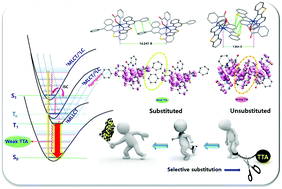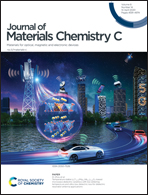Aggregation-induced phosphorescence enhancement in deep-red and near-infrared emissive iridium(iii) complexes for solution-processable OLEDs†
Abstract
To fight against the counteractive triplet–triplet annihilation and vibrational deactivation faced by low bandgap phosphorescent emitters, aggregation-induced phosphorescent enhancement (AIPE)-active deep-red and NIR emissive iridium(III) complexes are designed by suitably anchoring electron-withdrawing substituents such as -phenyl (Ir2), -ethyl ester (Ir3), and -trifluoromethyl (Ir4) groups on the N-coordinating quinoline moiety of a (benzo[b]thiophen-2-yl)quinoline cyclometalated ligand along with ancillary picolinate. The fundamentals of the origin of AIPE on Ir2 and Ir4 and its associated excited-state properties are deeply studied through comparison with unsubstituted Ir1 with the help of density functional theory and single-crystal X-ray diffraction analysis. Most importantly, AIPE-active Ir2 is employed for the development of efficient deep-red and NIR PhOLEDs by hybrid solution-processable methods, in which the AIPE effect of Ir2 reaches a maximum external quantum efficiency (EQE) of 7.29% at high doping ratios.



 Please wait while we load your content...
Please wait while we load your content...